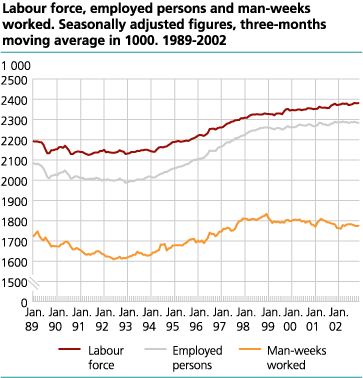Content
Published:
This is an archived release.
Increasing female employment
The unemployment increased and the employment showed signs of stagnation from the third to the fourth quarter of 2002 shows seasonal adjusted figures from the Labour Force Surveys (LFS) (see separate article ). The difference between women and men when it comes to labour force participation is decreasing.
The gap between males and females concerning the labour force participation is still diminishing. In 2002 70 per cent of the females and 77 per cent of the males were economically active, a difference of 7 percentage points. Ten years ago the difference was 12 percentage points, and 23 twenty years ago, according to the Labour Force Surveys.
During the last four years the activity rate has decreased with one percentage point for males, while it has increased with one and a half percentage point for females. From the fourth quarter 2001 to the fourth quarter 2002 there has been a small decline in both the female and the male activity rate totally. For males the unemployment is increasing and the employment decreasing.
Unemployment increased
A total of 87 000 persons were unemployed in the fourth quarter of 2002, accounting for 3.7 per cent of the labour force, compared with 3.3 per cent the same quarter the previous year.
The rate of long-term unemployment increased from 18 to 22 per cent last year. Long-term unemployed are those who have been continuously unemployed for more than six months at the time of the survey.
There were 80 000 underemployed in the fourth quarter of 2002, i.e. part-time employed seeking more work. As a percentage of all part-time employed, this corresponds to 13.3 per cent, compared with 11.8 per cent the same quarter 2001.
More employees in health and social work
Compared with the fourth quarter of 2001, there was increased employment within health and social work. Agriculture and business activities, on the other hand, showed a decline in employment.
Unemployment increased in EU and OECD
While the seasonally adjusted unemployment rate in Norway increased from 3.8 per cent in August to 4.1 per cent in November 2002, it increased from 7.6 to 7.7 per cent as an average in the EU. The rate in the OECD-countries increased from 6.9 to 7.0. In November 2002 the unemployment rate was 6.0 in USA (5.7 in August 2002), 5.0 in Sweden (4.7 in August), and 8.9 in Finland (9.2 in August). This is according to figures from OECD .
Temporary employment
There were 198 000 temporary employed in the fourth quarter of 2002, approximately the same amount of temporary employed people in the same period the previous year . This corresponds to 9.4 per cent of all employees. The rate of temporary employment was highest in health and social work, hotels and restaurants and in education, lowest in manufacturing and construction.
Tables:
- Table 1. Population aged 16-74 in the labour force, man-weeks worked, registered unemployed persons and persons employed by government measures. 1000 and per cent
- Table 2. Population aged 16-74 år in the labour force, employed persons and unemployed persons by sex (LFS). 1000 and per cent
- Table 3. Persons in the labour force and employed persons by age and sex (LFS). 1 000 and per cent
- Table 4. Population aged 16-74, employed persons by settled/usual working hours per week(1) and unemployed persons by age and sex (LFS). 1000
- Table 5. Persons in the labour force by age and sex. 1000 and as per cent of all in each group
- Table 6. Employed persons by sex and settled/usual working hours pr week (LFS). 1 000
- Table 7. Population aged 16-74 by main activity, part-time employment 1 and age (LFS). 1 000
- Table 8. Employed persons by major industry division. 1000
- Table 9 Number of man-hours worked per week 1, by industry division (LFS). 1 000
- Table 10. Employed persons,total, and employed persons at work by status and sex. Number of man-hours worked and actual working hours per week (LFS)
- Table 11. Population aged 16-74, employed persons, temporary absence from work and reason for absence, by sex(1). 1000 and per cent
- Table 12. Employees with temporary jobs, by major industry division (LFS). 1000 and as per cent of all employees
- Table 13. Unemployed persons by sex and age (LFS). 1000 and per cent
- Table 14. Unemployed persons by duration of job search (LFS). 1000 and per cent
- Table 15 Unemployed persons by main activity (LFS). 1 000
- Table 16. Unemployed and underemployed persons, by sex and desired working hours per week. Number of man-weeks (of 37,5 hours) supplied (LFS). 1000
- Table 17. Persons aged 16-74 years by labour force status, seasonally adjusted, three-months moving average. 1000
- Table 18. Persons in the labour force by sex and region (LFS). 1 000 and in per cent of total
- Tabell 19. Employed persons by sex and region (LFS). 1 000
- Table 20. Employed persons by sex and regions (LFS) as per cent of all inn each group
- Table 21 Employed persons, by some major industry division and region (LFS). 1997-2002. 1 000
Contact
-
Arbeidsmarked og lønn
E-mail: arbeidsmarked@ssb.no
-
Erik Herstad Horgen
E-mail: erik.horgen@ssb.no
tel.: (+47) 93 08 68 62
-
Håvard Hungnes Lien
E-mail: havard.lien@ssb.no
tel.: (+47) 40 90 26 06


